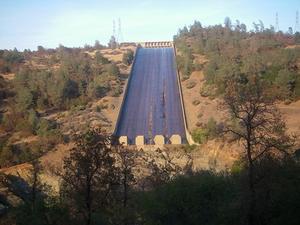DamsFeds, Calif. disagree on seismic safety of U.S. tallest dam
At 742 feet, Oroville Dam in Oroville, California is the tallest dam in the United States. It is 45-year old, and federal inspectors say it needs a comprehensive earthquake safety assessment. The California Department of Water Resources (DWR) insists that the dam, which holds 3.5 million acre-feet of water, is safe, and that such an assessment would be an “unjustified expense.” David Gutierrez, chief of California Division of Safety of Dams (DSD), says his agency will decide in January 2014 whether earthquake assessments will be made, but notes: “Oroville is not one that keeps me up at night from a seismic stability standpoint.”

A spillway of California's Oroville Dam // Source: bigstockphoto.com
A federal inspection has concluded that Oroville Dam in Oroville, California, needs a comprehensive earthquake safety assessment.
Oroville Dam, completed in 1968, at 742 feet tall, is the tallest dam in the nation. The dam, on Feather River, stores 3.5 million acre-feet of water and serves as a storage facility for the State Water Project, a California-owned plumbing system which provides drinking water to more than twenty-three million California residents. Should the dam fail during an earthquake, flooding could occur in the city of Oroville and extend to Yuba City, Marysville, and West Sacramento.
The Sacramento Bee reports that the 2010 inspection, conducted by consultants working for the Federal Energy Regulatory Commission (FERC), found no significant flaws in the dam itself. Inspectors recommended the earthquake safety assessment based on recent information about earthquake hazards in the vicinity of the dam.
The California Department of Water Resources (DWR) has no plans to conduct the assessment due to what the department considers to be an “unjustified expense,” but requests by state and federal regulators may force an assessment.
State water officials claim the dam is strong. “Even with today’s understanding of seismicity and ground motions, Oroville still would meet the criteria that would be set today,” said David Panec, chief of dam safety at the DWR’s operations and maintenance division. “The dam is essentially overbuilt.”
Experts that believe the dam is strong against an earthquake refer to the 5.7 magnitude quake that occurred near the dam in 1975. Subsequent investigations revealed that the dam performed well and did not incur any damage.
“We’ve seen these types of dams perform very well in earthquakes under very strong shaking,” said Ross Boulanger, a civil engineering professor at University of California, Davis and an expert on earthquake risk involving earthen and rockfill dams, like Oroville.
The Sacramento Bee reports that experts who call for an assessment of Oroville Dam are comparing the dam to numerous other dams in California which have shown vulnerability to earthquakes. TheFolsom Dam,located twenty-three miles northeast of Sacramento, is undergoing millions of dollars in upgrades to withstand earthquakes. The Lake Perris dam in Riverside County and the San Luis Reservoir in Merced County, part of the State Water Project, are also undergoing upgrades.
Ronald Stork, a senior policy advocate at Friends of the River,noted that the Oroville Dam exhibits a case of reservoir-induced seismicity. In such a case, the reservoir itself can cause earthquakes due to the weight of water stored behind the dam being large enough to shift the earth’s crust. Studies have documented the case at Oroville. “A dam with a whole lot of shaking going on … does seem to be something you need to be really careful about,” said Stork, who monitors dam regulation across the state. “You lose a 3.5million acre-foot reservoir — the tallest in the United States — and that could cause a whole mess of downstream trouble.”
Any suggested repairs from the proposed assessment at Oroville Dam will be paid for by twenty-nine urban and agricultural water contractors which purchase water from the State Water Project. Contractors are hesitant to absorb new costs which will be eventually passed on to their customers. Recently, two expensive and high-profile accidents which occurred at the dam have resulted in millions of dollars in costs.
“There is no doubt in my mind this is all a big dance over how these new costs are going to be apportioned,” said Leah Wills, a water consultant to Plumas County. “The contractors are kind of legitimately panicked. Somewhere there’s going to be this huge blank check that lands in their laps.”
The DWR could be required to conduct an Oroville Dam earthquake assessment either by the FERC or by the state’s Division of Safety of Dams (DSD), a separate regulatory unit within the DWR. David Gutierrez, chief of DSD, expects his agency to decide in January 2014 whether further earthquake assessments will be made. Regarding the dam and earthquake vulnerability, he notes, “Oroville is not one that keeps me up at night from a seismic stability standpoint.”
